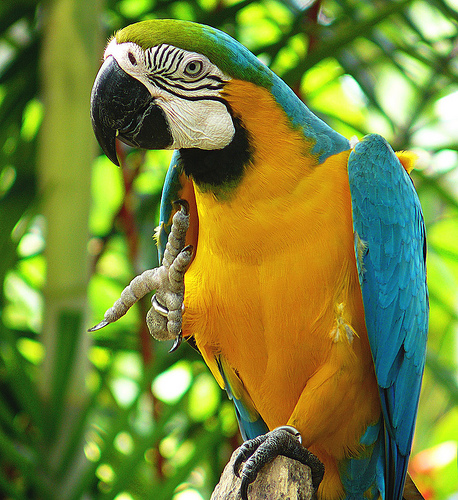

,We don’t recommend them (or any of the large Macaws) for Apartment living. Loudness: Like all Macaws, the Blue and Gold Macaw can be pretty vocal at sunrise and sunset, but with a strict routine and discipline you can teach your Macaw to keep the noise level down. It’s quite amazing to see! It is one of the few birds that we will suggest as a first bird as they accept new people quite readily, have a great personality, and posses a great combination of friendliness and speaking ability. Blue and Gold Macaw, will stand on its head, upside down, in the palm of your hand when prompted correctly. They typically develop good vocabularies, and can be taught to perform tricks on cue. Blue and Gold Macaws learn quickly and are easy to train with a little effort. Birds naturally ledge from the nest and their mothers, so hand-feeding a baby you intend to keep for life is not the best idea. It is recommended that you purchase your Macaw while still on hand feeds so that it will form a strong bond with you and your family. It is absolutely of utmost importance that you properly socialize your bird from a very young age. Train ability: As with most of the large Macaws, Blue and Golds are mischievous and a eternal 4 year old toddler. Origin: South America ( Specifically, Panama south to Brazil, Bolivia and Paraguay) You will also receive lots of free step by step trick training for your bird. This will include DNA sex & Hatch Certificates with free training and manuals on how to raise and care for your African Grey. Pricing: Congo African Greys currently sells for R3800.00. Congos can make nice apartment birds if they are properly trained

They learn their sounds from their surroundings, after all. If the household is frequently busy and noisy, then the bird will be, too. In general, the rule is that they will be quiet birds if they are raised in a quiet household. They can get a little noisy when they are involved in a rough-and-tumble game, but otherwise they are pretty quiet. Loudness: Congo African Greys are not overly loud birds. Congos are incredibly intelligent parrots and will need plenty of toys and one-on-one time with their caretakers to occupy them. Our pet African Grey, Marley are so well socialized he will go to any person regardless or sex, age or color. This however can be avoided by following the tips and advice you will receive with your chick. Although there is not much difference between the Timneh and the Congo, it has been said that Congos tend to be “one-person” birds – bonding only with their favorite person, and being intolerable of all others. A few individuals, for whatever reason, choose not to. They are infamous for their talking ability and will continue learning throughout their lifetime, though there is no guarantee that each and every bird will talk. They commonly sound like their caretaker, copying male or female voices and inflections. Trainability: Congo African Greys are excellent talkers and will often learn to mimic sounds before moving on to words and phrases.

Origin: Africa (Specifically, parts of the Ivory Coast, Kenya, and Tanzania) All African Greys are DNA sexed and will be accompanied with DNA- & Hatch Certificates. Sexing: Sexing these birds requires a DNA test, as they are not sexually dimorphic and you cannot tell the sex just by looking at them. We sell our babies weaned (eating on their own) and well socialized. Unlike the Timneh African Greys, which have two-toned beaks, the beak of a Congo is entirely black. Most individuals will maintain a bare patch of skin near their eyes, which will remain white. They are entirely grey, with the exception of their brilliantly red tails. Physical Description: Congo African Grey parrots are probably the most well-known bird in the entire pet industry.


 0 kommentar(er)
0 kommentar(er)
